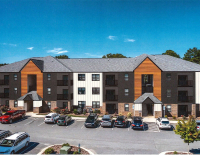Between the lines tells the story: Waynesville woodworker carves into passion
When you are in the presence of the woodwork by Ben Grant, you find yourself captivated by the contours of his pieces.
HCC breaks ground on new craft building
Dominic Cruz is counting down the days to graduation in May, when he will put his skills both as a woodworker and entrepreneur to work as he launches his dream career building handmade furniture.
Cruz moved to the region from Florida to attend the Creative Arts Program at Haywood Community College, where he says he learned everything he need to know to make a go of his venture.
“That’s what’s really, really great about this program,” Cruz said. “It doesn’t just teach you the skills and techniques, they have a ton of business classes so you are ready to succeed when you come out. It’s not just ‘here’s how you put something together.’”
That type of reputation — one that draws students from across the country — is rare for a two-year community college. But at HCC, the nationally renowned craft program has long had that kind of draw. The program has produced expert weavers, potters, glassblowers, jewelers and woodworkers considered among the best in their professions.
“I specifically sought out this college because people told me what a great program it was,” said Sherri Bell, who is originally from Alabama. “We have some really, really talented teachers.”
HCC broke ground last week on a new creative arts building. It will replace the cramped and outdated quarters that have housed the program for more than 30 years. The new building will help HCC maintain its status in the craft world and elevate awareness of the college in general, said HCC President Rose Johnson.
While some HCC graduates make a full-time living in the craft industry, for many like Bell, who works at a restaurant in Asheville, their craft will provide supplemental income and afford a higher quality of life.
“The presence of a creative workforce is associated with rising household incomes,” said Terry Gess, head of the Creative Arts Program at HCC. The craft industry has an economic impact of $206 million in Western North Carolina, according to a study by Handmade in America.
That’s good news to Richard Hughes, who hopes his budding artistic talents as a jeweler will help him earn enough to get off disability.
“I was trying to do something to improve my standing and get off the government nickel. I would rather be a productive member of society, so I am giving it my best shot,” Hughes said.
HCC’s craft program is inexpensive compared to private craft institutions, said Sarah Canale, who is in the jewelry program.
“I think it is impressive a community college can offer a quality craft program with a degree that’s affordable. It’s really unique,” Canale said.
The high demand among students to get in to HCC’s craft program leads to a perpetual waiting list.
“Some students have given up because there wasn’t space for them,” said HCC President Rose Johnson.
The new creative arts building will allow the college to increase enrollment, Johnson said. But not just for fulltime students. Johnson said she is equally excited about the having a bigger and better facility to serve the hundreds of people who do crafts as a hobby and take courses here and there as continuing education without pursuing degrees.
“It will certainly expand what we are able to do,” Brian Warst, a woodworking instructor, said of the new building.
The new building reflects a commitment to the craft industry, both by the college and the community, said Terry Gess, head of the Creative Arts Program at HCC.
“Over the decades, Western North Carolina has grown into a nationally known crossroads for crafts,” Gess said. “We look forward to our prosperous future in the creative arts.”
The $10.2 million creative arts building will be paid for with revenue from a special a quarter-cent sales tax levied in Haywood County for the sole purpose of construction and expansion at HCC.
Counties normally can’t impose sales taxes of their own accord. But in 2007, the state agreed to let counties enact a quarter cent sales tax if it passed muster with voters.
Haywood County promptly took the state up on the offer with HCC leading the charge. Voters were promised the money would be spent on building at HCC — something that would otherwise have to come from the county’s general coffers.
“We as a community owe a great gratitude to the voters of Haywood County of passing the quarter-cent sales tax,” said Neal Ensley, a member of the HCC board.
Haywood County Commissioner Bill Upton said it is a good thing the college jumped quickly.
“If we had to vote today on a quarter-cent sales tax, I don’t believe it would make it, so I appreciate the foresight of the Haywood Community College Board in getting this done,” Upton said.
Asheville-Buncombe Technical Community College is hoping to follow in HCCs footsteps. Buncombe voters will be asked on the ballot this fall to support a quarter-cent sales tax to fund new buildings for AB Tech.
Haywood commissioners finally give OK on HCC crafts building
After months of debate, Haywood Community College leaders emerged victorious this week in their quest to build a $10.3 million building where craft industries will be taught.
From weaving to pottery to woodworking, the new building will be a showcase for the college and a centerpiece for the vibrant arts and crafts community in Western North Carolina.
Haywood County commissioners had final say on whether the college could move forward, but for months they have been playing hardball over the building’s price tag. Ultimately, the commissioners approved the building Monday in a 4 to 1 vote.
Commissioner Kevin Ensley was the lone dissenting vote, but the other commissioners made it clear their support was tempered.
HCC President Rose Johnson said she is thankful the commissioners approved the project and the college can move forward with construction. The process was far more controversial than Johnson likely anticipated, however. A new craft building had long been the college’s top construction priority — since before Johnson became president.
“There was no way I could foresee how complicated it was going to be,” Johnson said.
Ultimately what convinced commissioners was unanimous backing by the college board of trustees itself. Until recently, the college trustees had been split on various aspects of the project, from the total building price tag to solar energy features. But last week, on the eve of a final vote by the county, the trustees convened and unanimously endorsed the project.
“They wanted to go to the commissioners with a unified vote,” Johnson said.
Mark Bumgarner, chairman of the HCC board, admits the move was critical. Commissioners said as much as well.
“If you had come in here today and it was still a 6-5 decision, I would be uncomfortable that you didn’t have a stronger consensus,” said Commissioner Chairman Kirk Kirkpatrick. “I don’t want to be in the position as a commissioner to stop a project another board wants to go forward with. If they are all in consensus now with the project, I would feel comfortable approving it, but not because I am sold on it completely.”
“Now that you have a consensus I feel a lot better,” agreed Commissioner Bill Upton.
The college has trimmed nearly $1 million from the project over the past month. Unfortunately, it doesn’t bring the price tag any lower than before. Bids from contractors came in higher than architects had estimated, forcing the college to cut elements of the building just to hold the line on the cost.
The higher-than-expected estimates came as a shock to both the college and commissioners. The depressed economy has, in most cases, led to lower building costs as contractors compete for limited work.
“This is the first project I have heard of in two or three years that came in above the estimated cost,” Ensley said.
Ensley said the reason the college had such high bids was the cutting-edge nature of the design. Ensley said he heard from contractors who either didn’t bid at all or who bid high because some eco-components of the building were unfamiliar.
Commissioners didn’t pass up one last chance to lecture college leaders over the price tag before signing off on the project. The building will be paid for out of a special quarter-cent sales tax approved by county voters two years ago. The county had pledged to dedicate revenue from the quarter-cent sales tax to community college construction if voters would approve it.
But Commissioner Skeeter Curtis said the county is ultimately on the hook for the loan.
“If something happened to the sales tax and it went south, that means the county would have to pick it up,” Curtis said. Curtis said the county doesn’t want to have to raise taxes in the future due to poor financial planning today.
Swanger warned the college not to bank on the special pot of sales tax money as being their own forever.
“I think it is important that all of us go into this with our eyes wide open,” Swanger said.
A decade from now, there will be a different cast of characters, with different priorities and campaign pledges than today’s board, Swanger said. While today’s commissioners pledged to devote the special sales tax to the college, it could easily be co-opted by a future board for a different use, he said.
It makes it all the more critical that the college be certain they want to burn through the lion’s share of the money on this one building, Swanger said.
Commissioners told the college not to come back later asking for more money for other projects.
“You know the lack of funds we have for projects for the community college outside this pool of money,” Kirkpatrick said.
When the recession hit, the county cut the building maintenance budget for the college by two-thirds. Commissioners said it could be a long time before that maintenance budget is restored. That means the college may need to dip into the special pot of sales tax money for regular maintenance.
When commissioners first broached that possibility earlier this year, supporters of the college came out in force to protest what they saw as commissioners reneging on their earlier promise to devote the sales tax money to campus expansion and new construction.
But times are tough, Ensley said.
HCC fiber students create Sandburg rug
Haywood Community College Professional Crafts-Fiber students recently delivered a Navajo rug they crafted to the Carl Sandburg Home National Historic Site in Flat Rock.
The students were commissioned to craft a replica of a worn and faded Navajo rug that once was in the Carl Sandburg home.
The project required extensive research to learn how to do traditional Navajo art. Not only did the students have to learn a new style of weaving, but they also had to experiment with dye. Sometimes it took several tries to get the colors to match closely to the original rug.
Students used the original rug as a reference when they were creating the weaving and color pattern. They each took turns working on the rug.
The HCC Foundation received $2,300 for the commission of this project to be used in the Fiber Department.
Carl Sandburg Home National Historic Site is dedicated to preserving the legacy of Carl Sandburg and communicating the stories of his works, life and significance as an American poet, writer, historian, biographer of Abraham Lincoln, and social activist.
HCC not taking no as an answer
Haywood Community College remains hopeful that the county will increase funding to the college, despite reluctance by the county commissioners to provide what they see as special treatment to HCC amidst across the board budget cuts.
“I view it as an unresolved issue at this point,” said HCC President Rose Johnson.
During the recession, commissioners slashed capital funding to the college and public school system by two-thirds, cut out nonprofits completely and laid off nearly 40 county employees.
The county had previously promised to pay for two new roofs and a major renovation at HCC with the annual contributions. But now, commissioners plan to dip into a special sales tax fund to pay for the projects.
The special sales tax was approved by voters specifically to fund expansions at HCC — not maintenance, according to college leaders. The college wants the county to restore its annual maintenance budget and reserve every penny of sales tax revenue for new construction and expansion.
Johnson met with county commissioners earlier this month to plead the college’s case and plans to meet with the board again soon.
Community college building costs come under fire
Haywood Community College leaders say county commissioners are unfairly accusing them of overspending on a new $10.2 million complex where arts and crafts will be taught.
Last week, Commissioner Kevin Ensley called it the most expensive building per square foot that he has ever seen in the county.
Now, HCC has dug up research to show that its creative arts building will cost less than similar construction at other community colleges in the state.
Ensley had compared HCC’s cost per square foot to that of recent construction projects in Haywood County, including the new jail, justice center and Bethel Elementary School. But HCC countered that community colleges are subject to stringent new state energy standards that lead to higher expenses. Plus, the craft trades require specialized equipment, from a $15,000 dust collection system for the woodworking shop to a $16,000 pottery wheel.
“I think the main thing is that everyone is talking about the same thing when they’re talking about the cost,” said Debbie Trull, director of administrative services. “It can be complex, and it can be confusing.”
But Commissioner Mark Swanger said Ensley’s comparisons are valid, even though they include different types of buildings.
“Every construction project has special features,” Swanger said. “In a school for example, you have a whole restaurant inside it. The jail, of course, has a complete security system.”
HCC claims that state requirements for energy efficiency could have added as much as 4 percent to the construction cost. The energy-hungry pottery kilns, welding equipment and shop tools made it especially costly to meet state guidelines — forcing the college to install more energy saving features than normal to offset their high energy use.
At a board of trustees meeting last Wednesday, HCC claimed that its new facility would cost $203.97 per square foot. According to HCC’s research, the average total project costs for such buildings are $283 per square foot statewide.
HCC also cited a national study conducted by McGraw-Hill that showed construction at colleges routinely costs 160 percent higher than K-12 schools.
“We need to be comparing apples to apples, instead of apples to oranges,” said HCC President Rose Johnson.
But County Commissioner Kevin Ensley said the college is the one that’s not comparing apples to apples.
“What they are doing is dancing around the numbers,” Ensley said.
To come up with a square foot cost of $203.97, the college omitted architect fees and site preparation and used only the estimated cost of the construction contract. But when taking the total project into consideration, the cost is $245 a square foot: $10.2 million for 41,000 square feet.
As for numbers from other colleges, HCC factored in the total project cost, including architect fees and site preparation — creating an unparallel comparison to its own numbers.
When Ensley was doing his comparison of recent construction projects, he used the total project cost — even if that meant factoring in the cost of buying land and putting in a septic system in the case of the new Bethel school.
Ensley said HCC is pushing the envelope on environmentally-friendly features for the new building and that’s what is driving up the costs. The building as planned would likely qualify for the “platinum” level green building designation.
“I think they want a platinum building, and we aren’t in a platinum economy right now,” Ensley said. “Some of these initiatives are extremely expensive.”
But HCC leaders say that isn’t the case, according to pricing they’ve done on the building with and without the green features.
Trull maintains that the college has already tried to be as cost-conscious as possible, but it won’t initiate a total redesign to please commissioners.
“The design is at the point where it would cost money to go back,” said Trull.
But Ensley said it is not hard for a contractor bidding on the project to provide a baseline cost estimate along with a separate breakdown of extras, Ensley said. Ensley wants county staff to review the construction documents and see if there are potential savings.
“I’m going to continue looking at it,” Ensley said.
Ultimately, county commissioners have to approve the college’s loan on the building. It will be paid for with revenue from a special quarter cent sales tax. County voters approved the special tax in 2008 for the express purpose of funding community college expansion.
It brings in enough each year to cover payments on 15-year $12 million loan, which is more than enough to pay for the creative arts building. But the college has a wish-list of other expansion projects it hopes to fund with sales tax money. Commissioners would like to see the money stretched further.
“I don’t want to see $10.2 million eaten up by this one building,” Ensley said.
Swanger and Ensley didn’t say whether they would hold veto the project if costs aren’t brought down, but they aren’t satisfied at this point. Swanger said he will keep an open mind and is eager to hear whatever new information the college plans to present.
“We all want this to work,” Swanger said. “We want the community college to have good, updated, safe facilities. That’s the reason we are looking closely at this. We want the money to go as far as it can to reach that goal.”
Building costs
Haywood Community College researched construction costs at five other colleges that spent far more on their buildings, including:
• Alamance Community College, which spent $301 per square foot for its technology center.
• Catawba Valley Community College, which spent $226 per square foot for industrial and technical building.
• Wilson Community College, which spent $320 per square foot on a heath & technology building.









